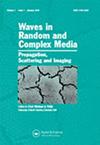Physics-based models for communications in random complex propagation media, including keyhole effects in MIMO
3区 物理与天体物理
Q1 Engineering
引用次数: 0
Abstract
AbstractExtensive research has been reported on MIMO systems for complex environments. It is noted that many communications studies make use of the channel matrix of transmitters and receivers, signal vectors, SNR, and eigenvalues. However, the channel matrix is often expressed in terms of channel modeling, and the detailed statistical characteristics of the channel in terms of physical characteristics of atmospheric turbulence, particulate matter, and rough surfaces and terrain are often not explicitly shown. This paper discusses the inclusion of expressions of physical characteristics of the random medium in the channel matrix. Therefore, the key point of this paper is that the channel matrix is explicitly given in terms of the actual physical parameters of the random environment using the mutual coherence function and stochastic Green’s functions; we call this a ‘physics-based’ communications model. This paper presents a formulation of physics-based communications models in the presence of a random medium based on analytical statistical EM theory. We use the keyhole MIMO as an example to show the key points of this approach. It is hoped that this study may help extend channel modeling to include analytical statistical EM theory for atmospheric turbulence, ocean turbulence, and rough terrain.KEYWORDS: Channel capacitycommunicationsMIMOrandom media AcknowledgementsThe careful assistance and insights of John Ishimaru are gratefully appreciated.Disclosure statementNo potential conflict of interest was reported by the author(s).随机复杂传播介质中基于物理的通信模型,包括MIMO中的锁孔效应
摘要针对复杂环境下的MIMO系统进行了广泛的研究。值得注意的是,许多通信研究都利用了发射机和接收机的信道矩阵、信号矢量、信噪比和特征值。然而,通道矩阵通常以通道建模的方式表示,而通道在大气湍流、颗粒物、粗糙表面和地形等物理特征方面的详细统计特征往往没有明确显示。本文讨论了在信道矩阵中包含随机介质物理特性的表达式。因此,本文的重点是利用互相干函数和随机格林函数,用随机环境的实际物理参数显式地给出信道矩阵;我们称之为“基于物理的”通信模型。本文提出了一种基于解析统计电磁理论的随机介质存在下基于物理的通信模型。我们以锁孔MIMO为例来说明这种方法的要点。希望这项研究可以帮助扩展通道建模,包括大气湍流、海洋湍流和崎岖地形的分析统计电磁理论。关键词:信道容量;通信;随机媒体感谢石丸先生的细心协助和真知灼见。披露声明作者未报告潜在的利益冲突。
本文章由计算机程序翻译,如有差异,请以英文原文为准。
求助全文
约1分钟内获得全文
求助全文
来源期刊

Waves in Random and Complex Media
物理-物理:综合
自引率
0.00%
发文量
677
审稿时长
3.0 months
期刊介绍:
Waves in Random and Complex Media (formerly Waves in Random Media ) is a broad, interdisciplinary journal that reports theoretical, applied and experimental research related to any wave phenomena.
The field of wave phenomena is all-pervading, fast-moving and exciting; more and more, researchers are looking for a journal which addresses the understanding of wave-matter interactions in increasingly complex natural and engineered media. With its foundations in the scattering and propagation community, Waves in Random and Complex Media is becoming a key forum for research in both established fields such as imaging through turbulence, as well as emerging fields such as metamaterials.
The Journal is of interest to scientists and engineers working in the field of wave propagation, scattering and imaging in random or complex media. Papers on theoretical developments, experimental results and analytical/numerical studies are considered for publication, as are deterministic problems when also linked to random or complex media. Papers are expected to report original work, and must be comprehensible and of general interest to the broad community working with wave phenomena.
 求助内容:
求助内容: 应助结果提醒方式:
应助结果提醒方式:


